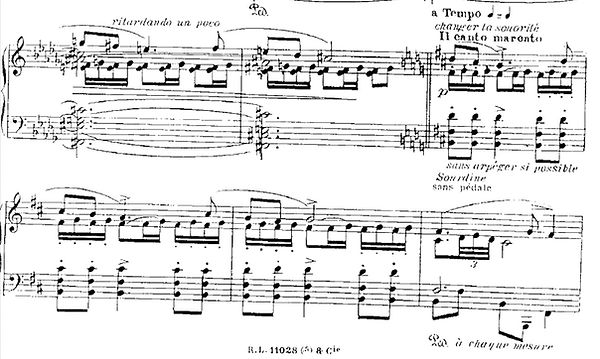
-
"Le Retour des muletiers"
The final fast-paced number of Cerdanya emulates the passage of the muleteers transporting goods from Roussillon to Spain through the Cerdanya. In addition to the passage of the mules and wagons, there is the singing of the muleteers (Ex. 16) and once again, the theme of "Hope".

Ejemplo 16. “Le Retour des muletiers”, cc. 1-6.Fuente: Séverac, Déodat de. Cerdaña: etudes pittoresques pour Piano. París: Rouart-Lerolle & cie, 1919, 53.
This number begins with a broad tenth chord, which we have already seen is a common resource of Séverac and the texture of the coblas. Another recurring practice of the two is repeated notes, and this number relies almost entirely on them in the accompaniment. The joyful melody, formed by joint degrees and thirds like many popular melodies, imitates the flabiol and tible (Ex. 16).
In one of the passages, we hear explicitly for the first time in the whole work the sardana dance, specifically the sardana llarga rhythm, with the accompaniment of two eighth notes and crotchet repeated as an ostinato and which is incorporated into the theme of "Hope" (Ex. 17 and min. 1:44). For that reason, just before starting to play the sardana I launch a track with the flabiol introduction that always sounds to start the dance and between the different parts. Prior to this fragment, when the sardana begins to be intuited with the repeated notes, the tresets and a very rhythmic second voice, my performance is interrupted to make way for a recording that includes part of the speech that was made to inaugurate the sardana of the Festa de l'Estany of 2022 (Ex. 17 and min. 1:11).

Ejemplo 17. “Le Retour des muletiers”, cc. 52-57.Fuente: Séverac, Déodat de. Cerdaña: etudes pittoresques pour Piano. París: Rouart-Lerolle & cie, 1919, 56.
The rest of the tracks I have included in this issue are related to the way goods are transported today. That is why tractor and truck engines are heard to start the different tracks: in m. 28 (min. 0:38), link to the first repetition of the first track where you hear a truck running in which the cargo it is transporting is moving; m. 69 (min. 2:20), link to the third section where a more sonorous tractor engine is heard coinciding with a repetitive and percussive A sharp that announces a new theme; m. 95 (min. 2.57), link to the repetition of the first theme in B flat where the whistle of a truck's reverse turn is heard; and m. 110 (min. 3:15), link to the last appearance of the "Hope" theme.
In the bars that link to the theme of "Hope" for the last time, the truck can be heard passing by, far away, much faster than the passing of the muleteers... (Ex. 18). I have chosen this fragment to launch this track as a reference to the frenetic and hurried pace of life that we usually lead, everything happens so fast, that we almost don't notice it, like this truck. And just after that begins the theme of "Hope", bucolic, relaxed and suggestive of so many small but good moments. At the end we hear again the vibrato of the flabiol to leave behind the rhythmic liveliness of the piece to conclude the Suite.

Ejemplo 18. “Le Retour des muletiers”, cc. 114-119.Fuente: Séverac, Déodat de. Cerdaña: etudes pittoresques pour Piano. París: Rouart-Lerolle & cie, 1919, 60.












